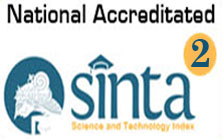Partner and Household Factors Associated with Breastfeeding Practice: A Systematic Review
Downloads
The role of partner and family in breastfeeding practice is still rare. Previous studies were more likely to discuss the impact of infant and mother factors. This study aimed to examine the role of partner and family factors associated with breastfeeding factors. This systematic review includes 18 journal articles from four databases such as PubMed, ScienceDirect, SCOPUS, and Scholar Google. The selection of journal articles was described in the PRISMA diagram. The findings revealed that the factors from partners including education, support, knowledge about breastmilk, age, and occupation, and factors from family and household including food security, family support, family intention, and type of family play a role in influencing the breastfeeding practice. Since this study only focused on partner and household factors, the findings emphasize the significant role of partner and family in improving the breastfeeding practice. The government and related stakeholders can take an important role in contributing to increasing the participation of partners or husbands in breastfeeding practices such give parental leave to support the wife during exclusive breastfeeding.
Agrina, A., Afandi, D., Suyanto, S., Erika, E., Dewi, Y. I., Helina, S., Pramita, D., & Safira, N. (2022). Analysis of Supporting Factors Associated With Exclusive Breastfeeding Practice in the Urban Setting During the COVID-19 Pandemic. Children, 9(7), 1074. https://doi.org/10.3390/children9071074
Ahmed, F., Malik, N. I., Shahzad, M., Ahmad, M., Shahid, M., Feng, X. L., & Guo, J. (2022). Determinants of Infant Young Child Feeding Among Mothers of Malnourished Children in South Punjab, Pakistan: A Qualitative Study. Frontiers in Public Health, 10. https://doi.org/10.3389/fpubh.2022.834089
Ahmed, M. S., Whitfield, K. C., & Yunus, F. M. (2022). Trends and predictors of early initiation, exclusive and continued breast-feeding in Bangladesh (2004-2018): A multilevel analysis of demographic and health survey data. British Journal of Nutrition, 128(9), 1857–1867. https://doi.org/10.1017/S0007114521004761
Arksey, H., & O’malley, L. (2005). Scoping studies: towards a methodological framework. International Journal of Social Research Methodology, 8(1), 19–32. https://doi.org/10.1080/1364557032000119616
Awang, M. N., Kristin, D. M., & Woda, W. A. (2023). The Role of Breastfeeding Fathers in Patriarchal Culture in East Sumba Regency East Nusa Tenggara Province. Devotion Journal of Research and Community Service, 4(3), 704–708. https://doi.org/10.36418/devotion.v4i3.425
Bennett, A., & Kearney, J. (2017). Insights From Fathers in Ireland on Their Ability to Support Their Breastfeeding Partner. Proceedings of the Nutrition Society, 76(OCE1). https://doi.org/10.1017/s0029665117000210
Berde, A. S., & Yalçin, S. S. (2016). Determinants of Early Initiation of Breastfeeding in Nigeria: A Population-Based Study Using the 2013 Demograhic and Health Survey Data. BMC Pregnancy and Childbirth, 16(1). https://doi.org/10.1186/s12884-016-0818-y
Chen, C., Cheng, G., & Pan, J. (2019). Socioeconomic Status and Breastfeeding in China: An Analysis of Data From a Longitudinal Nationwide Household Survey. BMC Pediatrics. https://doi.org/10.1186/s12887-019-1551-2
Chhetri, S., Rao, A. P., & Guddattu, V. (2018). Factors affecting exclusive breastfeeding (EBF) among working mothers in Udupi taluk, Karnataka. Clinical Epidemiology and Global Health, 6(4), 216–219.
Chien, L., Lee, E. Y., Coca, K. P., Paek, S. C., Hong, S. A., & Chang, Y. (2022). Impact of COVID-19 on Breastfeeding Intention and Behaviour Among Postpartum Women in Five Countries. Women and Birth. https://doi.org/10.1016/j.wombi.2022.06.006
Cohen, S. S., Alexander, D. D., Krebs, N. F., Young, B. E., Cabana, M. D., Erdmann, P., Hays, N. P., Bezold, C., Levin-Sparenberg, E., Turini, M., & Saavedra, J. M. (2018). Factors Associated With Breastfeeding Initiation and Continuation: A Meta-Analysis. The Journal of Pediatrics, 203, 190-196.e21. https://doi.org/10.1016/j.jpeds.2018.08.008
Cozma-Petruț, A., Filip, L., Banc, R., Mîrza, O., Gavrilaș, L. I., Ciobârcă, D., Badiu-Tişa, I., Hegheş, S. C., Popa, C., & Miere, D. (2021). Breastfeeding Practices and Determinant Factors of Exclusive Breastfeeding Among Mothers of Children Aged 0–23 Months in Northwestern Romania. Nutrients. https://doi.org/10.3390/nu13113998
Dede, K. S., & Bras, H. (2020). Exclusive Breastfeeding Patterns in Tanzania: Do Individual, Household, or Community Factors Matter? International Breastfeeding Journal, 15(1), 32. https://doi.org/10.1186/s13006-020-00279-8
Gebremariam, K. T., Zelenko, O., Mulugeta, A., & Gallegos, D. (2020). A Cross-Sectional Comparison of Breastfeeding Knowledge, Attitudes, and Perceived Partners’ Support Among Expectant Couples in Mekelle Ethiopia. https://doi.org/10.21203/rs.3.rs-19682/v2
Gogoi, I., Mahanta, T. G., & Barua, A. (2015). Prevalence of exclusive breastfeeding in slums of Dibrugarh Town and factors affecting the breastfeeding practice. Clinical Epidemiology and Global Health, 3, S58–S62.
Gutierrez-de-Terán-Moreno, G., Ruiz-Litago, F., Ariz, U., Fernández-Atutxa, A., Mulas-Martín, M.-J., Benito-Fernández, E., & Sanz, B. (2022). Successful breastfeeding among women with intention to breastfeed: From physiology to socio-cultural factors. Early Human Development, 164, 105518.
Iswara, S. ’., Utomo, M. T., & Ningtyas, W. S. (2022). Factors Associated With Exclusive Breastfeeding Practice by Mothers Who Work as Health Workers. Pediomaternal Nursing Journal, 8(2), 63–76. https://doi.org/10.20473/pmnj.v8i2.29448
Kabir, Md. A., & Islam, M. J. (2022). Trends of Breastfeeding Practice and Determinant Factors of Exclusive Breastfeeding in Bangladesh: Evidence From the Six Nationally Representative Cross-Sectional Surveys. American Journal of Multidisciplinary Research and Innovation. https://doi.org/10.54536/ajmri.v1i2.210
Kortsmit, K., Garfield, C. F., Smith, R., Boulet, S. L., Simon, C. D., Pazol, K., Kapaya, M., Harrison, L., Barfield, W. D., & Warner, L. (2020). Paternal Involvement and Maternal Perinatal Behaviors: Pregnancy Risk Assessment Monitoring System, 2012-2015. Public Health Reports, 135(2), 253–261. https://doi.org/10.1177/0033354920904066
Kumar, P., Mishra, P. S., Srivastava, S., & Sinha, D. (2021). What Predicts the Knowledge of Breastfeeding Practices Among Late Adolescent Girls? Evidence From a Cross-Sectional Analysis. Plos One, 16(10), e0258347. https://doi.org/10.1371/journal.pone.0258347
Lee, J., & Kim, T. (2020). Parental Socioeconomic Status as a Determinant of Breastfeeding : An Analysis of the Korea National Health and Nutrition Examination Survey ( 2013 ~ 2017 ). https://doi.org/10.21203/rs.3.rs-25616/v2
Li, R., Darling, N., Maurice, E., Barker, L., & Grummer‐Strawn, L. M. (2005). Breastfeeding Rates in the United States by Characteristics of the Child, Mother, or Family: The 2002 National Immunization Survey. Pediatrics, 115(1), e31–e37. https://doi.org/10.1542/peds.2004-0481
Makinde, O. A., Uthman, O. A., Ichegbo, N. K., Olamijuwon, E., & Okusanya, B. O. (2022). Vulnerability in Maternal, New-Born, and Child Health in Low- And Middle-Income Countries: Findings From a Scoping Review. Plos One, 17(11), e0276747. https://doi.org/10.1371/journal.pone.0276747
Manyeh, A. K., Amu, A., Akpakli, D. E., Williams, J. E., & Gyapong, M. (2020). Estimating the Rate and Determinants of Exclusive Breastfeeding Practices Among Rural Mothers in Southern Ghana. International Breastfeeding Journal, 15(1). https://doi.org/10.1186/s13006-020-0253-6
McQueen, K., Sieswerda, L. E., Montelpare, W., & Dennis, C. (2015). Prevalence and factors affecting breastfeeding among Aboriginal women in Northwestern Ontario. Journal of Obstetric, Gynecologic & Neonatal Nursing, 44(1), 51–68.
Ministry of Health Indonesia. (2018). Report of National Basic Health Research 2018. Jakarta: Ministry of Health Indonesia. Retrieved from http://www.depkes.go.id/resources/download/info-terkini/hasil-riskesdas-2018.pdf
Ministry of Health Indonesia. (2023). Pekan ASI Sedunia, Dukung Ibu Bekerja Beri ASI Eksklusif. Jakarta: Ministry of Health Indonesia. Retrieved from https://www.kemkes.go.id/id/rilis-kesehatan/pekan-asi-sedunia-dukung-ibu-bekerja-terus-menyusui
Mirahmadizadeh, A., Moradi, F., Zahmatkesh, S., Abasi, A., Salari, A., Hassanipour, S., & Mokhtari, A. M. (2020). Evaluation of breastfeeding patterns in the first 24 h of life and associated factors in south of Iran: a cross-sectional study. Clinical Epidemiology and Global Health, 8(1), 33–37.
Moher, D., Liberati, A., Tetzlaff, J., Altman, D. G., & Group*, P. (2009). Preferred reporting items for systematic reviews and meta-analyses: the PRISMA statement. Annals of Internal Medicine, 151(4), 264–269. https://doi.org/10.7326/0003-4819-151-4-200908180-00135
Muluneh, M. W. (2023). Determinants of Exclusive Breastfeeding Practices Among Mothers in Ethiopia. Plos One. https://doi.org/10.1371/journal.pone.0281576
Nepali, S., & Shakya, M. (2019). Husband’s Support for Breastfeeding and Breastfeeding Efficacy of Nepalese Mothers. Health Prospect, 18(1), 14–20. https://doi.org/10.3126/hprospect.v18i1.19060
Nuampa, S., Kuesakul, K., Prasong, S., & Sudphet, M. (2023). Social Support for Breastfeeding Practice During the COVID-19 Second Wave in Thailand: A Cross-Sectional Study. Journal of Human Lactation. https://doi.org/10.1177/08903344231156441
Nurokhmah, S., Rahmawaty, S., & Puspitasari, D. I. (2022). Determinants of Optimal Breastfeeding Practices in Indonesia: Findings From the 2017 Indonesia Demographic Health Survey. Journal of Preventive Medicine and Public Health. https://doi.org/10.3961/jpmph.21.448
Ogbo, F. A., Agho, K., & Page, A. (2015). Determinants of Suboptimal Breastfeeding Practices in Nigeria: Evidence From the 2008 Demographic and Health Survey. BMC Public Health, 15(1). https://doi.org/10.1186/s12889-015-1595-7
Ogbo, F. A., Akombi, B. J., Ahmed, K. Y., Rwabilimbo, A. G., Ogbo, A. O., Uwaibi, N. E., Ezeh, O. K., & Agho, K. (2020). Breastfeeding in the Community—How Can Partners/Fathers Help? A Systematic Review. International Journal of Environmental Research and Public Health, 17(2), 413. https://doi.org/10.3390/ijerph17020413
Permatasari, T. A. E., & Sudiartini, N. W. A. (2020). Do Health Workers Play a Role in Exclusive Breastfeeding Among Working Mothers in Industrial Area? Journal of Nutritional Science and Vitaminology. https://doi.org/10.3177/jnsv.66.s94
Piankusol, C., Sirikul, W., Ongprasert, K., & Siviroj, P. (2021). Factors affecting breastfeeding practices under lockdown during the COVID-19 pandemic in Thailand: a cross-sectional survey. International Journal of Environmental Research and Public Health, 18(16), 8729.
Ramadani, M. (2017). Dukungan keluarga sebagai faktor dominan keberhasilan menyusui eksklusif. Media Kesehatan Masyarakat Indonesia, 13(1), 34–41.
Reno, R., Whipps, M. D. M., Wallenborn, J. T., Demirci, J., Bogen, D. L., Gross, R. S., Mendelsohn, A. L., Morris, P., & Shaw, D. S. (2022). Housing Insecurity, Housing Conditions, and Breastfeeding Behaviors for Medicaid-Eligible Families in Urban Settings. Journal of Human Lactation, 38(4), 760–770. https://doi.org/10.1177/08903344221108073
Samaniego, J. A., Maramag, C. C., Castro, M. C., Zambrano, P., Nguyen, T. T., Datu-Sanguyo, J., Cashin, J., Mathisen, R., & Weissman, A. (2022). Implementation and Effectiveness of Policies Adopted to Enable Breastfeeding in the Philippines Are Limited by Structural and Individual Barriers. International Journal of Environmental Research and Public Health, 19(17), 10938. https://doi.org/10.3390/ijerph191710938
Schorn, M., Mendes, M. S., & Giugliani, E. R. J. (2023). Factors Associated With Breastfeeding Abandonment in the First Month After the Mother’s Return to Work. Ciência & Saúde Coletiva. https://doi.org/10.1590/1413-81232023289.19162022
Surbakti, E., Lumban Gaol, Y. H., & Hutabarat, J. (2021). Education The Importance of Husband Support in Early Initiation Of Breastfeeding in Material Mothers.
Syam, S., Fadjriah, R. N., & Faralizayani. (2022). Behavior of Working Mothers in Exclusive Breast Milk in the Work Area of Bulili Public Health Center. Journal of Health and Nutrition Research, 1(1), 49–55. https://doi.org/10.56303/jhnresearch.v1i1.22
Tan, K. W. (2011). Factors Associated With Exclusive Breastfeeding Among Infants Under Six Months of Age in Peninsular Malaysia. International Breastfeeding Journal, 6(1), 2. https://doi.org/10.1186/1746-4358-6-2
UNICEF. (2020). Situasi Anak di Indonesia. UNICEF.
UNICEF. (2023). Breastfeeding. UNICEF.
Vanderlinden, K., Buffel, V., Putte, B. V. d., & Velde, S. V. d. (2020). Motherhood in Europe: An Examination of Parental Leave Regulations and Breastfeeding Policy Influences on Breastfeeding Initiation and Duration. Social Sciences, 9(12), 222. https://doi.org/10.3390/socsci9120222
WHO. (2024). Breastfeeding. World Health Organization.
World Health Organization. (2021). Infant and Young Child Feeding. World Health Organization.
World Health Organization, & UNICEF. (2019). Global Breastfeeding Scorecard 2019. World Health Organization, & UNICEF.
Wu, W., Zhang, J., Zolezzi, I. S., Fries, L. R., & Zhao, A. (2021). Factors Influencing Breastfeeding Practices in China: A Meta‐aggregation of Qualitative Studies. Maternal and Child Nutrition, 17(4). https://doi.org/10.1111/mcn.13251
Copyright (c) 2024 JURNAL INFO KESEHATAN

This work is licensed under a Creative Commons Attribution-NonCommercial-ShareAlike 4.0 International License.
Copyright notice
Ownership of copyright
The copyright in this website and the material on this website (including without limitation the text, computer code, artwork, photographs, images, music, audio material, video material and audio-visual material on this website) is owned by JURNAL INFO KESEHATAN and its licensors.
Copyright license
JURNAL INFO KESEHATAN grants to you a worldwide non-exclusive royalty-free revocable license to:
- view this website and the material on this website on a computer or mobile device via a web browser;
- copy and store this website and the material on this website in your web browser cache memory; and
- print pages from this website for your use.
- All articles published by JURNAL INFO KESEHATAN are licensed under the Creative Commons Attribution 4.0 International License. This permits anyone to copy, redistribute, remix, transmit and adapt the work provided the original work and source is appropriately cited.
JURNAL INFO KESEHATAN does not grant you any other rights in relation to this website or the material on this website. In other words, all other rights are reserved.
For the avoidance of doubt, you must not adapt, edit, change, transform, publish, republish, distribute, redistribute, broadcast, rebroadcast or show or play in public this website or the material on this website (in any form or media) without appropriately and conspicuously citing the original work and source or JURNAL INFO KESEHATAN prior written permission.
Permissions
You may request permission to use the copyright materials on this website by writing to jurnalinfokesehatan@gmail.com.
Enforcement of copyright
JURNAL INFO KESEHATAN takes the protection of its copyright very seriously.
If JURNAL INFO KESEHATAN discovers that you have used its copyright materials in contravention of the license above, JURNAL INFO KESEHATAN may bring legal proceedings against you seeking monetary damages and an injunction to stop you using those materials. You could also be ordered to pay legal costs.
If you become aware of any use of JURNAL INFO KESEHATAN copyright materials that contravenes or may contravene the license above, please report this by email to jurnalinfokesehatan@gmail.com
Infringing material
If you become aware of any material on the website that you believe infringes your or any other person's copyright, please report this by email to jurnalinfokesehatan@gmail.com.





























